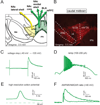Reward and aversion in a heterogeneous midbrain dopamine system
- PMID: 23578393
- PMCID: PMC3778102
- DOI: 10.1016/j.neuropharm.2013.03.019
Reward and aversion in a heterogeneous midbrain dopamine system
Abstract
The ventral tegmental area (VTA) is a heterogeneous brain structure that serves a central role in motivation and reward processing. Abnormalities in the function of VTA dopamine (DA) neurons and the targets they influence are implicated in several prominent neuropsychiatric disorders including addiction and depression. Recent studies suggest that the midbrain DA system is composed of anatomically and functionally heterogeneous DA subpopulations with different axonal projections. These findings may explain a number of previously confusing observations that suggested a role for DA in processing both rewarding as well as aversive events. Here we will focus on recent advances in understanding the neural circuits mediating reward and aversion in the VTA and how stress as well as drugs of abuse, in particular cocaine, alter circuit function within a heterogeneous midbrain DA system. This article is part of a Special Issue entitled 'NIDA 40th Anniversary Issue'.
Keywords: AADC; AMPAR; ATP sensitive potassium channel; Aversion; BLA; CLi; CM; ChR2; D2R; DA; DAT; Dopamine; GAD; IF; IPN; KATP; LDT; LHb; MSN; MT; Mesocortical; Mesolimbic; N-methyl-d-aspartate; NAc; NMDAR; PBP; PFC; PN; RLi; RMTg; RRF; Reward; SN; SNc; SNr; TH; VGluT2; VMAT2; VTA; Ventral tegmental area; amino acid decarboxylase; basolateral amygdala; caudal linear nucleus; channelrhodopsin 2; dopamine; dopamine D2 receptor; dopamine transporter; fasciculus retroflexus; fr; glutamic acid decarboxylase; interfascicular nucleus; interpeduncular nucleus; lVTA; lateral VTA; lateral habenula; laterodorsal tegmentum; mVTA; mammillary body; medial VTA; medial lemniscus; medial terminal nucleus of the accessory optical tract; medium spiny neuron; ml; nucleus accumbens; parabrachial pigmented nucleus; paranigral nucleus; prefrontal cortex; retrorubral field; rostral linear nucleus of the raphe; rostromedial tegmental nucleus; substantia nigra; substantia nigra pars reticulata; substantia nirgra pars compacta; tyrosine hydroxylase; ventral tegmental area; vesicular glutamate transporter 2; vesicular monoamine transporter 2; α-amino-3-hydroxy-5-methyl-4-isoxazolepropionic acid receptor.
Copyright © 2013 Elsevier Ltd. All rights reserved.
Figures


References
-
- Abercrombie ED, Keefe KA, DiFrischia DS, Zigmond MJ. Differential effect of stress on in vivo dopamine release in striatum, nucleus accumbens, and medial frontal cortex. J. Neurochem. 1989;52:1655–1658. - PubMed
-
- Albanese A, Minciacchi D. Organization of the ascending projections from the ventral tegmental area: a multiple fluorescent retrograde tracer study in the rat. J. Comp. Neurol. 1983;216:406–420. - PubMed
-
- Anstrom KK, Woodward DJ. Restraint increases dopaminergic burst firing in awake rats. Neuropsychopharmacology. 2005;30:1832–1840. - PubMed
Publication types
MeSH terms
Substances
Grants and funding
LinkOut - more resources
Full Text Sources
Other Literature Sources
Research Materials
Miscellaneous

